Seven Sorrows Rosary -
16 Promises of Our Lady of Sorrows
The 16 Promises of the Seven Sorrows Rosary
In The Glories of Mary, Saint Alphonsus Liguori recounts a tradition stemming from a revelation made to Saint Elizabeth of Hungary in the 13th century, during which the Virgin Mary and Jesus Christ appeared to the apostle Saint John after their death. Mary then asked her Son to grant special graces to those who would be devoted to her sorrows. Jesus promised her four main graces. Praying the Seven Sorrows Rosary allows one to benefit from these four promises of grace:
That those who invoke the divine mother by her sorrows, before death will merit to obtain true repentance of all their sins.
That He will protect such in their tribulations, especially at the hour of death.
That He will impress upon them the memory of his passion, and that they shall have their reward for it in heaven.
That He will commit such devout servants to the hands of Mary, that she may dispose of them according to her pleasure, and obtain for them all the graces she desires.
According to tradition, a century later, in the 14th century, the Virgin Mary revealed to Saint Bridget of Sweden seven promises of grace for those who would meditate daily on her Seven Sorrows by reciting seven Hail Marys. The recitation of the Seven Sorrows Rosary also fulfills the conditions for obtaining these seven additional promises:
I will grant peace to their families.
They will be enlightened about the divine Mysteries.
I will console them in their pains and will accompany them in their work.
I will give them as much as they ask for as long as it does not oppose the adorable will of my divine Son or the sanctification of their souls.
I will defend them in their spiritual battles with the infernal enemy and I will protect them at every instant of their lives.
I will visibly help them at the moment of their death - they will see the face of their mother.
I have obtained this grace from my divine Son: that those who propagate this devotion to my tears and sorrows will be taken directly from this earthly life to eternal happiness, since all their sins will be forgiven and my Son will be their eternal consolation and joy.
The Seven Sorrows Rosary benefits from specific promises of grace revealed by the Virgin Mary. During the Marian apparitions in Kibeho, Rwanda, Mary revealed to Marie-Claire Mukangango, one of the three visionaries approved by the Church, the graces associated with the recitation of the Seven Sorrows Rosary. The main grace is that when this rosary is recited while meditating on her sorrows, it gives “the strength to repent” and helps to fight our vices. It also helps us to ask God for forgiveness by giving us true contrition for our sins. Promises of graces associated with the Seven Sorrows Rosary are sometimes found in the following form:
With the recitation of the Seven Sorrows Rosary, the hardest hearts shall change, if you pray it for yourself or for others.
By the recitation of the Seven Sorrows Rosary, you shall be freed from obsessions and addictions.
This rosary, when said from the heart, will win us true repentance of our sins and free our souls from guilt and remorse.
Those who say it often shall obtain clear understanding of their weaknesses and flaws causing them to sin and those things we don’t like about ourselves and thought were a part of our character, shall change.
You shall obtain whatever you ask for through this rosary, praying this rosary from the heart.
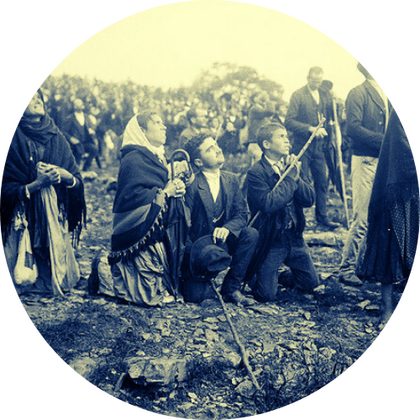
On October 13, 1917, the Virgin Mary appeared as Our Lady of Sorrows, among other forms, during the apparition in Fátima that led to the 'Miracle of the Sun'.
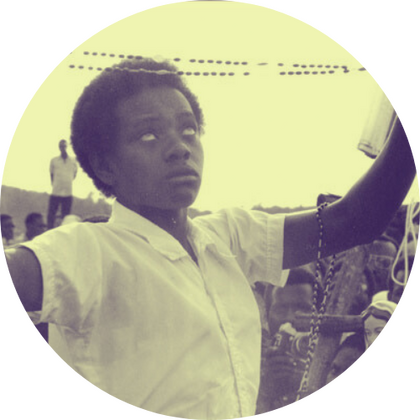
On March 6, 1982, the Virgin Mary appeared to Marie-Claire Mukangango in Kibeho, Rwanda, and taught her the Seven Sorrows Rosary. Mary then told Marie-Claire that she wanted this chaplet to be restored to honor and gave her the mission of spreading it throughout the world. The commission of inquiry found that Marie-Claire did not know this rosary prior to the apparition.
How to pray the Seven Sorrows Rosary ?
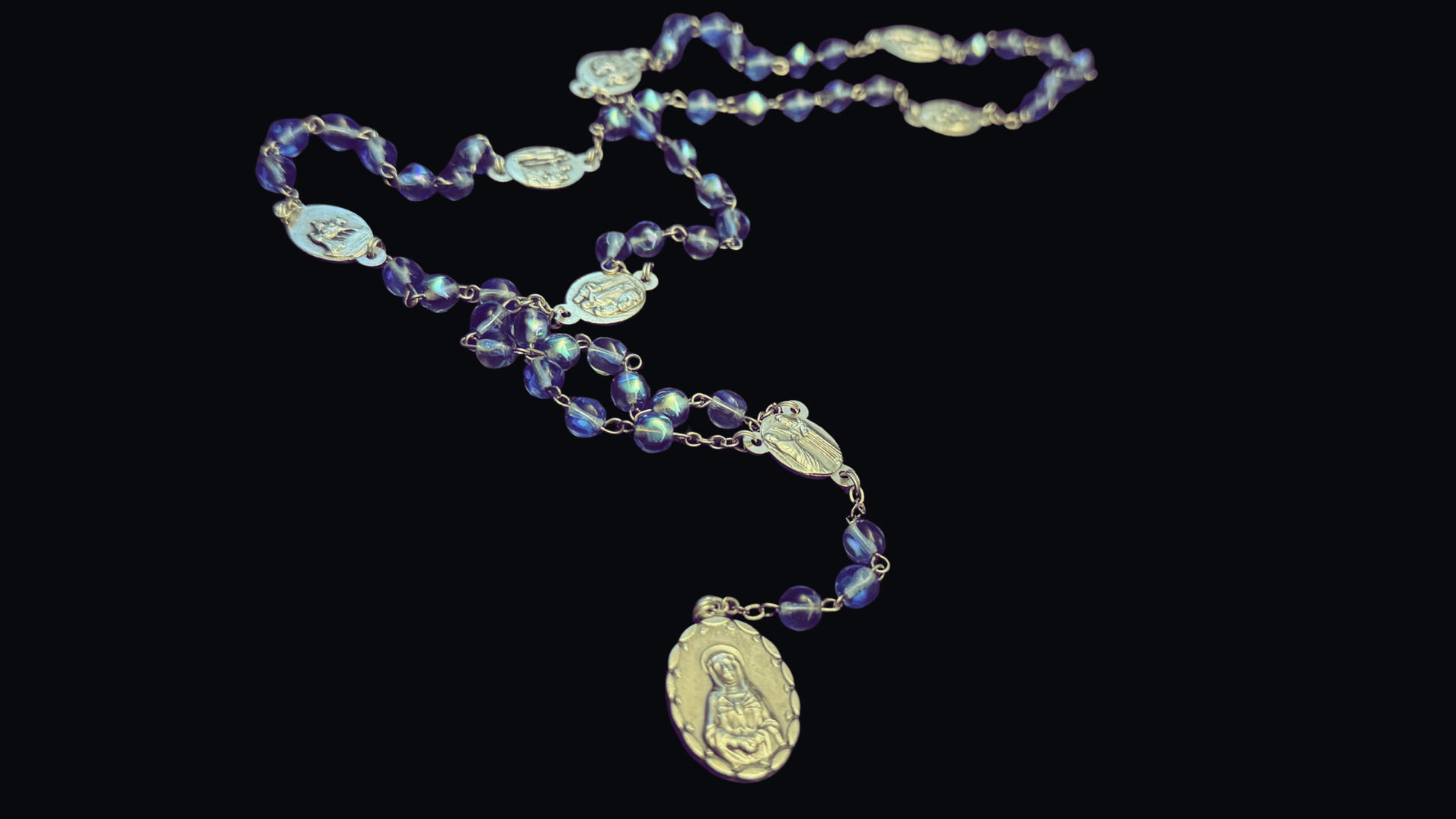
The Rosary of the Seven Sorrows of Mary originated within the Order of the Servants of Mary, founded in 1233 in Florence by seven merchants devoted to Our Lady of Sorrows. The Virgin Mary appeared to them on Good Friday, April 13, 1239, holding a black robe and accompanied by angels, some of whom carried the instruments of the Passion. She then asked the seven founders to wear this black habit in memory of her mourning and the sorrows she endured during the Passion of her Son. She also recommended that they meditate often on her sorrows if they wanted to be pleasing to her. The Order of Servites subsequently became one of the main promoters of the devotion to Our Lady of Sorrows, from which the Rosary of the Seven Sorrows developed.The Seven Sorrows Rosary is usually made of black beads, in reference to the Order of Servites, or light blue beads, representing Mary's tears. It is divided into seven sections, each consisting of a medal representing one of the Seven Sorrows of Mary, followed by seven small beads. It also has a tail consisting of three small beads and a large medal, for a total of 49 + 3 small beads.There are several variations in the recitation of the Seven Sorrows Rosary, sometimes including optional or specific prayers, but each of these variations are based on a common traditional structure, which the following:
• 1 Act of Contrition on the large introductory medal• 3 Hail Marys in honor of the tears of Mary, either at the beginning or end of the rosary• 1 Our Father on the medals (or large beads) at the beginning of each meditation on one of the Seven Sorrows• 7 Hail Marys on the small beads in honor of the Sorrow being meditated upon
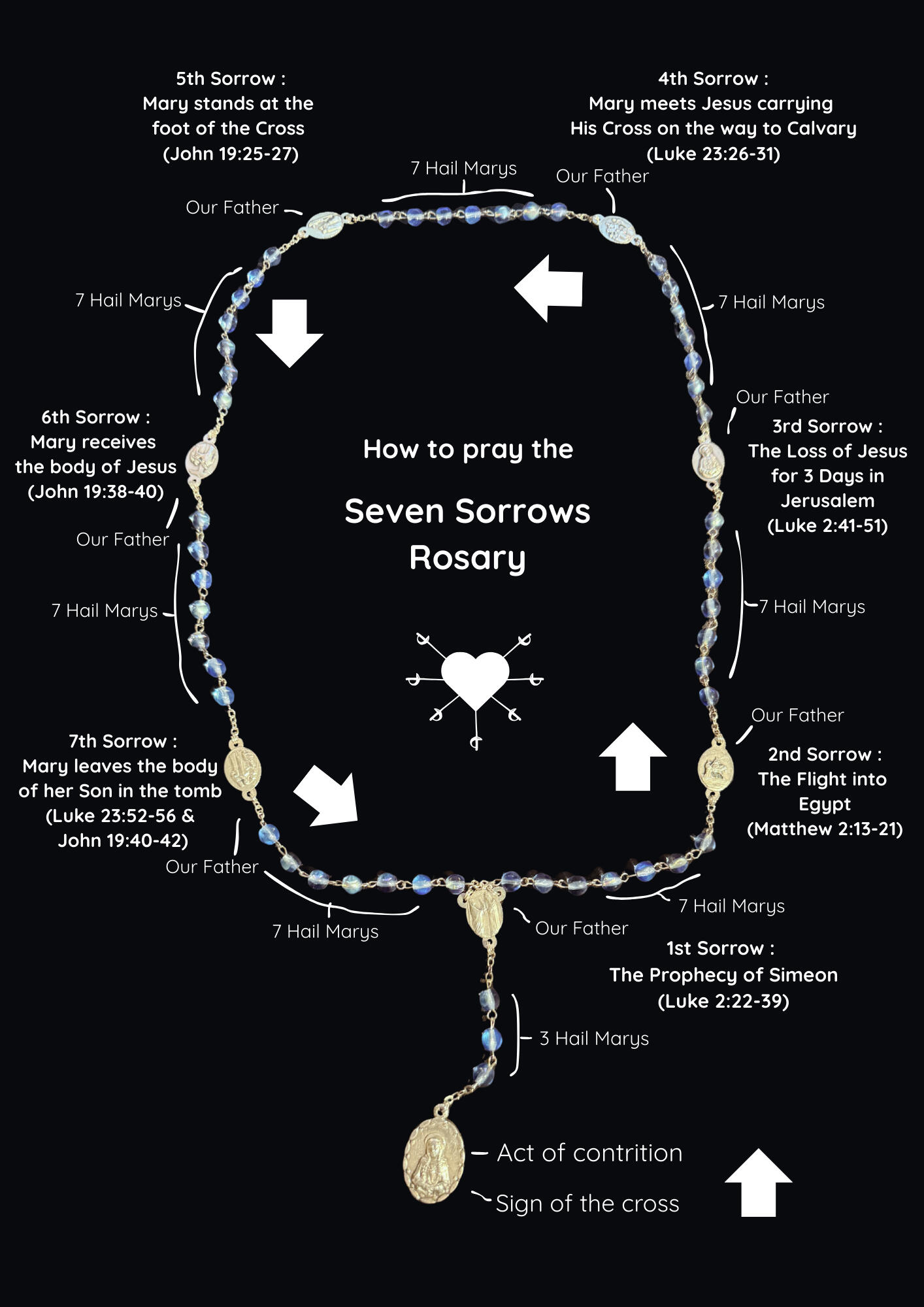
The Meditations -
The Seven Sorrows of Mary
In the same way as for the mysteries of the traditional Rosary, on each medal (or large bead), one announces and meditates on one of the Seven Sorrows experienced by Mary during her life. These sorrows, which are found in the Gospels, are as follows:
1. The Prophecy of Simeon
(Luke 2:22-39)
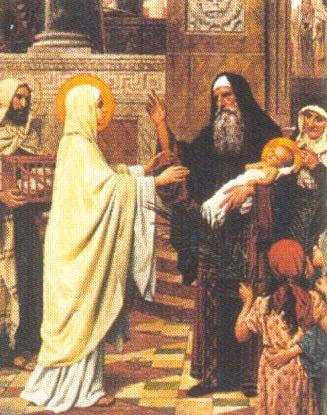
'When the time came for their purification according to the law of Moses, they brought him up to Jerusalem to present him to the Lord [...]. Then Simeon blessed them and said to his mother Mary, “This child is destined for the falling and the rising of many in Israel, and to be a sign that will be opposed so that the inner thoughts of many will be revealed—and a sword will pierce your own soul too.”'
2. The Flight into Egypt
(Matthew 2:13-21)
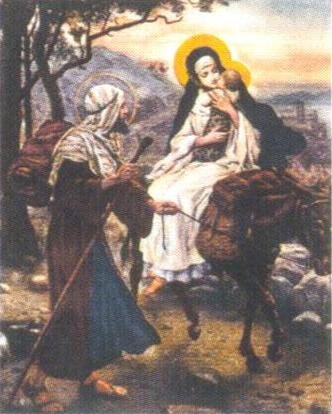
'Now after they had left, an angel of the Lord appeared to Joseph in a dream and said, “Get up, take the child and his mother, and flee to Egypt, and remain there until I tell you; for Herod is about to search for the child, to destroy him.” Then Joseph got up, took the child and his mother by night, and went to Egypt, and remained there until the death of Herod. This was to fulfill what had been spoken by the Lord through the prophet, “Out of Egypt I have called my son.”'
3. The Loss of Jesus for Three Days in Jerusalem
(Luke 2:41-51)
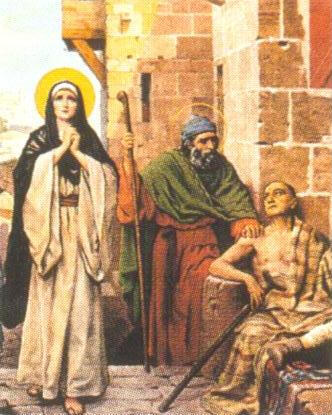
'When the festival was ended and they started to return, the boy Jesus stayed behind in Jerusalem, but his parents did not know it. [...] When they did not find him, they returned to Jerusalem to search for him. After three days they found him in the temple, sitting among the teachers, listening to them and asking them questions [...]. When his parents saw him they were astonished; and his mother said to him, “Child, why have you treated us like this? Look, your father and I have been searching for you in great anxiety.” He said to them, “Why were you searching for me? Did you not know that I must be in my Father’s house?” But they did not understand what he said to them. Then he went down with them and came to Nazareth, and was obedient to them. His mother treasured all these things in her heart.'
4. Mary meets Jesus carrying His Cross on the way to Calvary
(Luke 23:26-31)
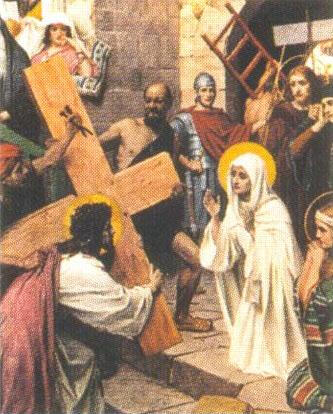
'But they kept urgently demanding with loud shouts that he should be crucified; and their voices prevailed. So Pilate gave his verdict that their demand should be granted. [...] As they led him away, they seized a man, Simon of Cyrene, who was coming from the country, and they laid the cross on him, and made him carry it behind Jesus. A great number of the people followed him, and among them were women who were beating their breasts and wailing for him.'
5. Mary stands at the foot of the Cross (John 19:25-27)
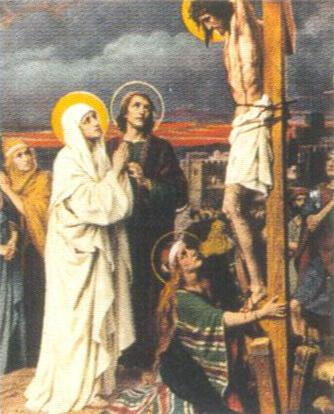
'Meanwhile, standing near the cross of Jesus were his mother, and his mother’s sister, Mary the wife of Clopas, and Mary Magdalene. When Jesus saw his mother and the disciple whom he loved standing beside her, he said to his mother, “Woman, here is your son.” Then he said to the disciple, “Here is your mother.” And from that hour the disciple took her into his own home.'
6. Mary receives the body of Jesus taken down from the Cross (John 19:38-40)
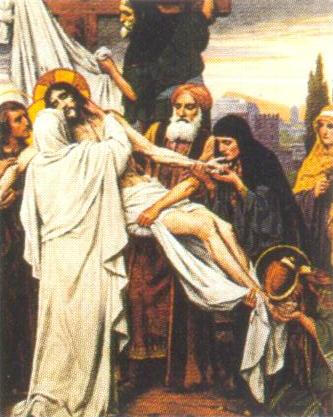
'After these things, Joseph of Arimathea, who was a disciple of Jesus, though a secret one because of his fear of the Jews, asked Pilate to let him take away the body of Jesus. Pilate gave him permission; so he came and removed his body. Nicodemus, who had at first come to Jesus by night, also came, bringing a mixture of myrrh and aloes, weighing about a hundred pounds. They took the body of Jesus and wrapped it with the spices in linen cloths, according to the burial custom of the Jews.'
7. Mary leaves her Son in the tomb (Luke 23:52-56 & John 19:40-42)
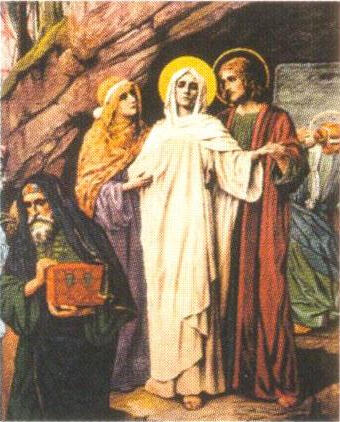
'Then he took it down, wrapped it in a linen cloth, and laid it in a rock-hewn tomb where no one had ever been laid. It was the day of Preparation, and the sabbath was beginning. The women who had come with him from Galilee followed, and they saw the tomb and how his body was laid. Then they returned, and prepared spices and ointments. On the sabbath they rested according to the commandment.'
Free of rights